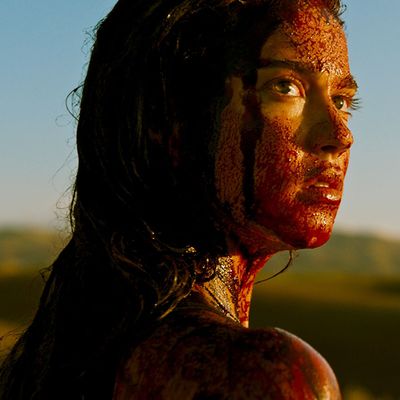
Spoilers below for Revenge.
The movie Revenge is a bare-knuckle punch to the face with a very big fist. The thriller stars Matilda Lutz as Jen, a woman on a desert getaway with her rich, married boyfriend, Richard (Kevin Janssens). What begins as a sexy, sweaty weekend in the middle of nowhere turns into a living hell when Richard’s hunting buddies arrive at his villa. Taking advantage of his absence one afternoon, one of his friends rapes Matilda while the other ignores her screams and watches TV in the nearby living room.
After the crime, Richard returns, and decides the only course of action is to dispose of the inconvenience and leave Jen to be consumed by the arid landscape. But what the attempted murder actually catalyzes is a resurrection, with Jen trawling the desert for her captors — and all four people hunting each other.
Revenge is hot and sticky and violent, with blaring colors and a primal soundscape provided by the composer Robin Coudert (also known as his stage name Rob), who’s also set the mood for movies like Horns and Maniac. But the true crowning achievement of Fargeat’s savage phantasmagoria is the movie’s final scene, in which Jen and Richard finally encounter one another again for a frantic, ultrabloody showdown. It starts with a long tracking shot of a naked, wet Janssens stalking through his house in search of Lutz, and quickly turns from a gunfight into a panicky circular chase, with Jen and Richard simultaneously pursuing and running from one another. One last tussle ends with her blasting a hole through his chest.
The scene stuffs all the tension built up in Revenge into a single canister, then detonates it like a bomb. To unpack how her movie’s epic conclusion came together, Vulture sat down with Fargeat to discuss the inversion of horror tropes, the role of nudity in showcasing power dynamics, the benefits of working on a tight budget, and why her on-set mantra was “More blood! More blood!”
Surprising the Audience on a Small Budget
Fargeat does a phenomenal job of entrancing the viewer with a scene that is, on its face, absurd: two people chasing each other around in a circle, barely wearing clothes, and carrying huge guns. At one point, Richard even Saran Wraps his torso to keep his guts from pouring out of a massive gunshot wound. “I like the moment where it becomes absurd, where it comes out of pain and out of reality and it becomes the madness in the mind of the characters,” says the director. “That’s what makes the tensions really grow.” And since Fargeat didn’t have the means to go with conventionally awesome effects, she knew she’d have to manufacture her “striking violence” in a more innovative way, which is how she arrived at the chase structure.
“I think it’s definitely one of my favorite scenes of the movie, because I love doing action, but in a surprising way. In action movies we have seen everything, and you could watch tons of cars exploding and buildings collapsing and you’re not surprised anymore. It’s not very creative, and when you don’t have money, you have to be creative in another way. In the end, I think the scene is more powerful, making the most of all the small ingredients rather than having huge explosions everywhere.” Another thing that had to go? A surreal interjection of a goat that wanders into the crossfire between the hero and villain.
Creative Choreography
With explosions off the table, Fargeat needed to make sure her parting shot honored the film’s operating philosophy, since the motivating force behind Revenge is stated pretty explicitly in that final scene: Richard grabs Jen by the throat, hoists her against a wall and growls, “Why do women always have to put up a fucking fight?”, impressing upon her his male entitlement to her feminine submission. It’s a moment in a scene that was part of the story from its first draft — but even though Fargeat knew how she wanted the movie to end, the exhausting chase actually took a long time to write, since she was still laying it out during shooting.
She also had to tweak her plan to work within the constraints of the villa where they filmed. To create the looping path of Jen and Richard’s pursuit, a false wall was built into the kitchen to create a corridor. With so many moving parts — actors running, camera equipment, a director of photography trying to keep up with everything, a ton of fake blood gumming up the walls and floor — Fargeat had to first choreograph the long, uncut shot that precedes Kevin and Jen’s chase to make sure no rogue crew members were caught in the frame or captured on reflective surfaces. That meant multiple days of rehearsal before they actually got the tracking shot — and then it was on to the gross part, where a nearly naked Lutz and a very naked Janssens would be covered in gluey fake blood and rapidly pursuing each other through a narrow hall.
Getting Naked
Having Janssens be the only naked one wasn’t just Fargeat’s way of subverting a cliché by putting a man in the unique position of being nude and vulnerable in front of a female aggressor; it was a full “fuck you” to the policing of women’s bodies onscreen as well as off. When we meet Jen, she’s a picture of mass-appeal temptation, with straw-blonde hair and puckered red lips wrapped around a lollipop. She wears oversize, winged-eye sunglasses and a bright-pink top that matches her star-shaped earrings. She unselfconsciously flits around the luxurious, isolated villa, and even after Richard’s hunting buddies show up, she continues to lounge in bikinis and just, well, live her life as a hot girl.
Jen dances with the men, flirts, and behaves like any woman would who’s feeling herself and thinks she is protected — in this case, by her big strong boyfriend. Then she’s raped and discarded, scantily clad in the barren desert. Fargeat made the crucial choice to keep her heroine exposed all the way through her vengeance quest. The director wanted to make sure Jen’s transformation into a survivor was not commensurate with a new modesty. From beginning to end, Lutz remains mostly unclothed, hunting down her assailants in a tactically fashioned sports bra and hot pants. For her final confrontation with Richard, Jen is fully embodied and confident in her exposed skin.
“I really didn’t want to have a character that would be half-naked at the beginning, who would transform into a warrior, who would dress up and be covered from head to toes, and would become strong because now she’s dressed, she has clothes on,” says Fargeat, who doesn’t consider her movie to be a rape-revenge film in the classic sense — and who has limited her exposure to the subgenre to Wes Craven’s Last House on the Left. “I loved the contrary the idea that she should be as seductive and provocative and as sexy as she wants. For me at the beginning, the problem is not the way she’s acting, but the male gaze on her and what they think they are allowed to do, because she is presenting herself a certain way. So it was very important for me that the character stays close to her body, which is her identity. And she decides to keep using it in a very naked way, too, having nothing and just her body as a tool to have a new strength.”
It was just as important to Fargeat’s intentions that Janssens be completely naked in Revenge’s final scene, which really serves as the movie’s thesis statement. The director explained that even though it was clearly laid out in the script, Janssens didn’t actually think she’d go through with the nudity. “We’re really gonna do it naked?” he asked. “Of course!” Fargeat told him. “It’s in the script!’” She explained to him that she needed Richard without “his outfits of power, like the clothes, the car, the gun, the villa — all what makes him the very powerful alpha man” so he was forced to be “face-to-face with himself, with the way he acts and who he is.” In return, Janssens went full History of Violence for her.
When In Doubt: Add More Blood
By the end of Revenge’s final scene, the posh vacation home looks like a slaughterhouse, with white rugs and couches shot to shreds and soaked in blood. It was hell on a logistics level, since they had to make a shot list that allowed for the build up of blood over time — especially since Fargeat would push her effects team to their limit with the sheer volume of blood on set. “I didn’t know I wanted so much!” says the director. “In fact, the SFX guys were freaking out to run out of blood, so they had stuff coming from Paris to be able to make more on the spot. They were making blood all the time, and so scared because there needed always more, more! It was never ending! I think the sentence you could use the most during those four days of shooting was ‘More blood! More blood!’”
When they finally started filming, the effects team tried gingerly applying the prop goo to walls, but after demanding more enough times Fargeat eventually just streamlined the process by pouring it all over the place. “We didn’t have time, so basically I took his bucket of blood and I started to splash it on the wall and the actor, putting blood on him and blood on the floor until you could feel something was really happening.” Then, of course, Fargeat, the actors, and a pared-down crew had to negotiate the floor being a crimson Slip ‘N Slide (no one was hurt!), with Lutz and Janssens trying not to get glued to each other, themselves, or the set. “For the actors, it turned out to be a nightmare, because they stuck to their own bodies and it was hurting like hell. Between shots they had to stand and it was very tiring and very uncomfortable and they were all sticky and they had all these prosthetics.”
Trust Your Instincts
Fargeat describes pulling off the finale scene as cracking a Rubik’s cube. She knew the necessary moves and in what order to make them, but since it mostly looked like a big old mess to everyone outside her head (as she shouted stage directions like “Run. Run more! On the left, on the right, more angry. No, reverse!”), it was a leap of faith for everyone else on set to get behind her.
“I think totally most of the crew had no idea of what we were filming, and of course many of them thought we were doing shit and this [made] no sense,” says Fargeat, whose faith in her own vision was strong enough to martial the support of her team. “With genre films, you’re always on the edge. It can be very ridiculous if you cross a line, or very good, and you never know on which side of the line you are. So you have to trust the director, even if at some points we were shooting fast and you don’t have time to fully understand how it’s gonna be. But I think they were really proud and surprised the first time they saw the movie, to discover what had been done. And that is the best reward for their hard work.”


